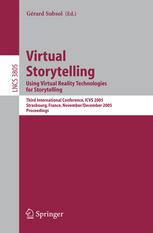

Most ebook files are in PDF format, so you can easily read them using various software such as Foxit Reader or directly on the Google Chrome browser.
Some ebook files are released by publishers in other formats such as .awz, .mobi, .epub, .fb2, etc. You may need to install specific software to read these formats on mobile/PC, such as Calibre.
Please read the tutorial at this link: https://ebookbell.com/faq
We offer FREE conversion to the popular formats you request; however, this may take some time. Therefore, right after payment, please email us, and we will try to provide the service as quickly as possible.
For some exceptional file formats or broken links (if any), please refrain from opening any disputes. Instead, email us first, and we will try to assist within a maximum of 6 hours.
EbookBell Team

4.8
104 reviewsThe 1st International Conference on Virtual Storytelling took place on September 27–28, 2001, in Avignon (France) in the prestigious Popes’ Palace. Despite the tragic events of September 11 that led to some last-minute cancellations, nearly 100 people from 14 different countries attended the 4 invited lectures given by international experts, the 13 scientific talks and the 6 scientific demonstrations. Virtual Storytelling 2003 was held on November 20–21, 2003, in Toulouse (France) in the Modern and Contemporary Art Museum “Les Abattoirs.” One hundred people from 17 different countries attended the conference composed of 3 invited lectures, 16 scientific talks and 11 posters/demonstrations. Since autumn 2003, there has been strong collaboration between the two major virtual/digital storytelling conference series in Europe: Virtual Storytelling and TIDSE (Technologies for Interactive Digital Storytelling and Entertainment). Thus the conference chairs of TIDSE and Virtual Storytelling decided to establish a 2 year turnover for both conferences and to join the respective organizers in the committees. For the third edition of Virtual Storytelling, the Organization Committee chose to extend the conference to 3 days so that more research work and applications could be be presented, to renew the Scientific and Application Board, to open the conference to new research or artistic communities, and to call for the submission of full papers and no longer only abstracts so as to make a higher-level selection.